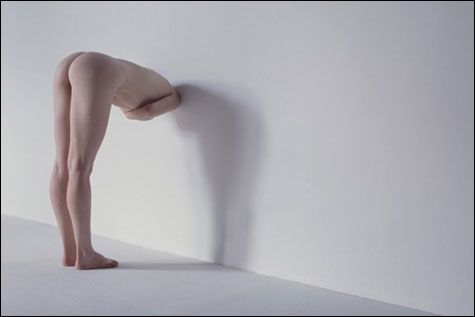
AWARD WINNER: Bill Durgin’s Cyc. 9 is part of the SFMA’s “Traveling Scholars” show. |
In 2008, the fourth dimension, time, steps to the fore in the art world — its passage, and our future, are clearly on many minds, as are ideas about slowing up, looking back, scaling down, and moving forward.
David Claerbout has a wily way with temporality. Using photography, video, and digital technology to move between fixed and time-based images, he’s developed what has been described as a “moving still,” to which he adds narrative elements. His slowly unfolding work rewards viewers who take their time. “DAVID CLAERBOUT,” at MIT’s List Visual Arts Center (20 Ames St, Cambridge; February 8–April 6), is the first museum survey of the Belgian artist’s work.
The transformation of a small pond north of Exeter, in England, as it undergoes successive periods of neglect and landscaping between 1996 and 2003 is the subject of “JEM SOUTHAM: UPTON PYNE,” at Wellesley College’s Davis Museum (106 Central St, Wellesley; March 19–June 8). The intimacy of Southam’s detailed narrative contrasts with “GRAND SCALE: MONUMENTAL PRINTS IN THE AGE OF DÜRER AND TITIAN,” which, up concurrently at the Davis, features woodcuts and engravings by ambitious early-16th-century artists intent on rivaling painted images.
Attempts to pin down nature’s fleeting tracks can be seen in “EVIDENCES: FOOTPRINTS, DRIPLINES, SCULPTURE AND DRAWINGS BY JOYCE AUDY ZARINS,” at the Essex Art Center (56 Island St, Lawrence; January 11–February 29), a show that focuses on a particular tree in Lawrence. And in “IMPERMANENCE: PHOTOGRAPHY BY SHELLEY ZATSKY,” also at the Essex Art Center (March 7–May 2), photographs of places on the National Trust for Historic Preservation’s “11 Most Endangered” list document the toll time takes on once-glorious buildings.
Looking at a photograph of a child, we might see vulnerability, purity, or experience beyond one’s years. “PRESUMED INNOCENCE: PHOTOGRAPHIC PERSPECTIVES OF CHILDREN,” at the DeCordova Museum (51 Sandy Pond Road, Lincoln; February 2–April 27), brings together 113 photographs dating from the early 20th century to the present; the collection includes a wealth of documentary and socially concerned works by such artists as Bruce Davidson and Mary Ellen Mark.
Time repeats itself in “BROKEN HOME, 1997/2007,” at Brandeis’s Rose Art Museum (415 South St, Waltham; January 23–April 13), a re-creation of a 1997 exhibition of the same name in New York’s Greene Naftali Gallery that included and will again include Robert Gober, Dan Graham, and Franz West, among others. Also at the Rose during this same period, “EMPIRES AND ENVIRONMENTS” pairs works from the Rose’s collection with contemporary artists like Wayne Gonzales and Nicole Cherubini, and “ARP TO REINHARDT: ROSE GEOMETRIES” focuses on examples of geometric abstraction from the Rose’s collection, with work by Ellsworth Kelly, Mary Heilman, and Al Held.
Pulling the rug out from under traditional gallery-going experience, “SOME SORT OF UNCERTAINTY,” presented at Axiom Gallery (141 Green Street, Boston; January 11–February 17) in collaboration with Art Interactive, encourages spectators to interact with seemingly empty spaces and otherwise activate as well as contemplate art by Bruce Campbell, Liz Nofziger, Douglas Weathersby, and others.
The role of the audience in the experience of art is also at issue in “THE WORLD AS A STAGE,” at the Institute of Contemporary Art (100 Northern Ave, Boston; February 1–April 27), with work by artists operating at the intersection of visual art and theater including Andrea Fraser, Jeremy Deller, and Catherine Sullivan. Likewise at the ICA, “MOMENTUM 10: RANJANI SHETTAR” (March 19–July 13) features site-specific work by an artist whose delicate sculptural installations make use of organic as well as industrial materials and have been interpreted as evoking her native Bangalore, a high-tech Indian city in rural surroundings.
Early artistic exchange along trade routes in the Indian Ocean is the subject of “LUXURY FOR EXPORT: ARTISTIC EXCHANGE BETWEEN INDIA AND PORTUGAL AROUND 1600,” at the Isabella Stewart Gardner Museum (280 the Fenway, Boston; February 8–May 4). The centerpiece of this scholarly show is a rare 17th-century silk embroidery made in Bengal for export to Portugal.
Eco-friendly materials are HOT in “IT’S GETTING HOT IN HERE,” at Montserrat College of Art Gallery (23 Essex St, Beverly; February 15–April 5), a show that reflects the growing trend toward making use of materials that have minimal environmental impact. Artists including Ellen Driscoll, Vaughn Bell, and Rachel Perry Welty make fine work using recycled, used, and/or locally found materials.
The role of brands in creating identity and the growing overlap among art, design, and commerce are considered in “BRANDED AND ON DISPLAY,” at Tufts University Art Gallery (40R Talbot Avenue, Medford; January 17–March 30). Ashley Bickerton, Diller + Scofidio, Philippe Parreno & Pierre Huyghe, and more employ many media in their scrutiny of the deep personal relationship we maintain with our belongings. Also at Tufts, at the same time, is “IVAN NAVARRO: NO MAN’S LAND”: the Chilean artist’s work is informed by his experience growing up under Augusto Pinochet’s dictatorship and by major figures in minimalism, particularly Dan Flavin and Tony Smith.